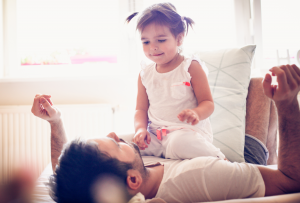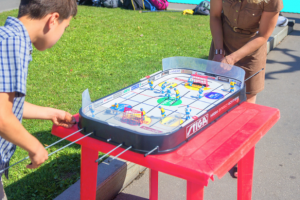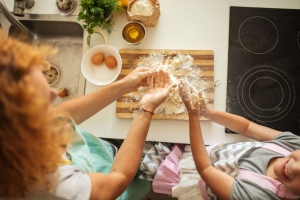In today’s day and age where families lead busy lives and parents are pulled in multiple different directions, being present and taking time to connect with your child is a common topic in parenting education and advice. What you may not know is how “being” with your child stimulates their brain.
Why Connect?
The truth is we are hard wired to connect. When this biological imperative is met there is not only a positive effect on the parent-child relationship, but also with your child’s brain chemistry.

Brain Development & Connection
Connection promotes brain development and growth by having the brain fire with neuron activity and creating new neural networks that lay the foundation for more complex brain functions (executive functioning and more advanced thinking).
Connection helps children feel safe to express their emotions and learn to regulate their own feelings.
Connection can decrease cortisol levels (stress hormone) and increase oxytocin (love or “cuddle” hormone).
Connection settles the nervous system and the amygdala or the part in the brain that is our “fear center”.
Connection creates a sense of “we” and strengthens the relationship.
Connection with caregivers through emotional availability (undivided attention) and reciprocal interactions (back and forth) activates the growth of the limbic system (where social and emotional learning occurs) and connects this part to the thinking regions of the brain.
Connections helps promote a sense of feeling safe and understood which contributes to the healthy attachment and the development of empathy.
In understanding the brain impact of connection, you may still be at a loss of what this type of connection looks like for you and your child, here are some suggestions for ways you can connect:
3 Crucial Times for Connection in Your Child’s Day
Research has shown the most important times in a child’s day to connect with them are first thing in the morning before starting your day, after school (if possible even if it’s a phone call or text until you are able to get home to see them in person), and at bedtime. Create a consistent and predictable way to connect during these times. With continued repetition eventually, your child will take the lead in initiating this with you and knowing what to expect.
.
How Can I Connect with My Child?
Ways to connect with your younger child(ren):
-Sing a special song and act out the actions with them. One of my favorites is “A bushel & a peck”” where you can hug and squeeze, give kisses (if your child is receptive) while singing with and to them.
-Give “Eskimo kisses” (rub noses go left to right back and forth) or “butterfly kisses “(touch eyelashes and go left to right back and forth)

-Blow bubbles with bubble gum and have them pop it
-Have them copy your facial expressions as they watch you and then switch and have them make faces with you copying
For other fun ways check out the book I Love You Rituals
Ways to connect with your older child(ren):
-Go on a “date” or outing where they chose what you do
-Play a game or sit and watch a movie together

– Write notes back and forth adding to what was written before or engage in journaling to each other
-At bedtime ask about their day. Ask specific questions to avoid getting “fine” for an answer. Need ideas? click here
-Work on a project or make something with your child

Looking for other ways to help with your child’s brain integration? The Whole-Brain Child: 12 Revolutionary Strategies to Nurture Your Child’s Developing Mind is a comprehensive guide that is an easy read to gain more understanding as a parent or professional working with parents.
Share how connections matters
Connection matters
Posted by Alyssa Caldbeck, LISW, RPT on Thursday, November 1, 2018
What’s your favorite connecting activity for a parent and child?
